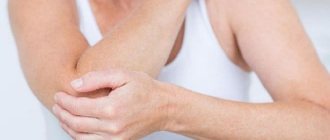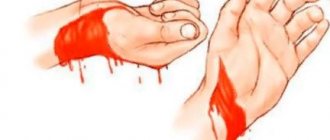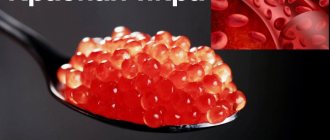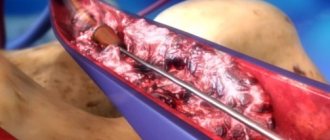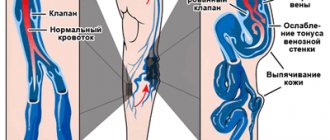Author
Frolov Konstantin Borisovich
Doctor
Candidate of Medical Sciences
Phlebologist
until November 30
We are giving away 1000 rubles for all services for a visit in November More details All promotions
Phlebectomy is a surgical treatment for varicose veins in which surgery is performed to remove areas of varicose veins. The saphenous veins are removed, the blood flow through which is no more than 10% of the total volume. The deep veins, which carry the bulk of blood, easily adapt to such a slight increase in load. As a result of the operation, blood flow is normalized and an aesthetic effect is achieved.
Nutrition after vein surgery
During rehabilitation after surgery for varicose veins in the legs, it is necessary to consume foods that thin the blood and strengthen the walls of blood vessels. It is important to adjust your diet and reduce your intake of fats and carbohydrates, especially if you are overweight.
It is better to boil and bake foods, but not to fry them. Vegetables should be eaten raw, they thin the blood. Salt and spices retain water in the body, and this provokes swelling, so you will have to give up smoked, spicy and salty foods.
The daily menu should include products containing:
- Vitamin C. Ascorbic acid strengthens the walls of blood vessels and thins the blood. Not only citrus fruits are rich in vitamin C, but also various types of cabbage, rose hips, sea buckthorn and currants.
- Vitamin R. Rutin makes the walls of blood vessels stronger and more elastic. Vitamin P is found in berries: grapes, cherries and black currants.
- Omega polyunsaturated fatty acids, proteins and taurine. These substances also increase the elasticity of blood vessels and are found in sufficient quantities in seafood. And also in unrefined sunflower, olive and flaxseed oils, which slow down the process of blood clots.
- Fiber. Coarse fibers tone the intestines and increase immunity by normalizing the intestinal microflora. Fresh vegetables, cereals and whole grain bread are rich in fiber. Plant products containing coarse fibers.
Indications for phlebectomy
Indications for phlebectomy are:
Photos before and after phlebectomy
- extensive varicose veins;
- pathological expansion of the saphenous veins;
- increased fatigue and swelling of the legs with varicose veins;
- signs of impaired blood outflow (heaviness in the legs, swelling, observed even in the absence of pronounced varicose veins of the superficial veins);
- complications of varicose veins (trophic ulcers, thrombophlebitis).
Phlebectomy is a radical method of treating varicose veins and is used when the disease has already gone beyond the initial stage and other treatment methods are ineffective. Currently, phlebectomy is not considered a dangerous operation, and modern methods of performing it are aimed at minimizing the damage caused to the body as a result of surgery. Therefore, if there are indications for phlebectomy, it should not be postponed.
Rehabilitation gymnastics
A doctor may prescribe exercise therapy, but gymnastics should be dosed and not cause overwork. Walking will help avoid stagnation of blood and hardening of the veins. This is the optimal physical activity for operated legs. Before walking, you should wear compression stockings or secure an elastic bandage.
If the recovery is going well and the patient plans to return to strength training, you need to remember that you should not lift weights at all for a week after surgery, and lifting weights of more than 7 kg is contraindicated for six months.
Performing phlebectomy
Phlebectomy - performing an operation
Before the operation, you need to be examined by a phlebologist and, if necessary, have an ultrasound. As a rule, a combined phlebectomy is performed, which is a combination of different methods used depending on which vessels are affected by varicose veins and what the degree of damage is. Combined phlebectomy includes:
- crossectomy - intersection of the saphenous varicose vein at the point where it flows into the deep vein;
- safenectomy is a traditional surgical intervention to remove large venous trunks;
- stripping – removal of varicose veins using a thin probe (only the part of the vein modified by varicose veins is removed);
- microphlebectomy – removal of varicose veins through small punctures using a special hook.
The widespread use of microphlebectomy techniques allows one to achieve an aesthetic effect. The operation is performed through small incisions (4-5 mm) and leaves behind almost invisible scars.
Preparation for the operation is minimal: just take a shower and carefully shave the hair in the operating area.
The operation is performed under spinal anesthesia. The planned operation time (including anesthesia) is 3 hours. The postoperative period of hospital stay is 1-2 days.
What can help in the fight against deep scars?
After complete recovery, a person can turn to cosmetologists to get rid of scars.
Laser technologies are most often used - the beam destroys collagen fibers, while simultaneously stimulating the production of fibroblasts (the building cells that make up our skin). They ensure the intensive production of fresh collagen and elastin - the skin is renewed, the scar is smoothed out. Laser scar removal requires 4–5 sessions, has many contraindications and is high cost. There is an option to get rid of the consequences of classic phlebectomy through surgery: specialists can excise the scar and cause new skin to grow. But carrying out another operation is not the most pleasant prospect. In addition, additional trauma to the skin can provoke a relapse, and the scar risks turning from hypertrophic into keloid . And this is the most aggressive scar, which is more difficult to treat than others.
Find out which scar correction method is optimal for you!
doctor Svetlana Viktorovna Ogorodnikova.
doctor
Varicose veins: recovery
Vein surgery is a serious intervention in the body; over the course of several months, a scar forms in the area of the operated vessels. This imposes certain restrictions on recovery
.
Immediately after the operation, the limbs are bandaged with elastic bandages or compression stockings are put on, which are selected in advance by the attending physician (degree of compression, type of medical underwear). The feet are placed on elevated bolsters and covered with ice. But lying down for a long time is not recommended! With minimally invasive interventions, you need to get up and walk within an hour or several hours. After phlebectomy (the so-called surgical removal of varicose veins) – one day later.
Main recommendations in the postoperative period
- Mandatory wearing of special jersey from 3 weeks to 2 months.
- After the intervention, especially after phlebectomy and mini-phlebectomy, drug treatment is prescribed during the recovery period. The course is aimed at eliminating pain, normalizing the tone of the veins and blood flow in them with the prevention of blood clots (anticoagulants), as well as relieving swelling (venotonics). Drugs are selected individually, taking into account the type of operation, tolerability and previous treatment, existing diseases. Course from 2 weeks to a month.
- Immediately after the operation and for the next 2 months, thermal procedures - baths, saunas, steam baths - are prohibited. If there are no special instructions from the doctor, then you can wash in the shower after 3 days or after removing the stitches (if they were applied), without harsh pressure and friction of the operated area.
- For 2 months you should not sunbathe or visit a solarium.
- It is important to maintain physical activity and take daily hour-long walks so as not to provoke deformation of the remaining veins. Active leg movements are shown, during which the muscles of the legs and thighs contract. Individual selection of a physical activity regime is also necessary. In order for recovery after varicose vein surgery
to be productive and positive, it is important to avoid prolonged lying and sitting, which leads to blood stagnation and the risk of complications, especially in overweight and elderly patients. - If varicose vein surgery is performed, recovery
is relatively quick. But during this period it is important to monitor the operation site. Any changes in this area (redness, itching, pain, swelling) require consultation with a doctor.
After about a month, it is quite possible to return to your previous lifestyle, but without lifting heavy objects, hypothermia or overheating of the legs, prolonged sitting or standing.
After surgery for varicose veins, recovery involves regular individual visits to the doctor. This depends on the volume and type of intervention, the patient’s age and existing concomitant pathologies.
How to choose knitwear for varicose veins?
Therapeutic knitwear with a compression effect is mandatory for use after surgery. Patients already before surgery have a question about how to choose knitwear for varicose veins
, what types of products to choose for the postoperative and subsequent rehabilitation period. Compression hosiery must be purchased in advance! Regardless of what operation will be performed, compression hosiery must, first of all, be of high quality and selected strictly according to size and other parameters. It is worth choosing knitwear from well-known European companies specializing in the manufacture of these medical products. The compression class is determined by the doctor.
After surgery on the veins, as a rule, knitwear of the second compression class is used, which applies therapeutic pressure to the deep veins. While products of the first compression class affect the superficial veins.
Features of the use of medical knitwear
- The doctor applies knitwear or elastic bandages immediately after surgery to reduce the risk of bleeding and hematoma formation. The product must be brought with you on the day of the operation.
- For the first few days, knitwear is worn constantly; in some cases, it is recommended not to take it off for the first 2-3 days, even at night.
- Socks, stockings, tights (the type of knitwear selected by the attending physician) should be put on in the morning, without getting out of bed, and worn throughout the day.
- It is recommended to wear these products for 1-2 months after surgery, which reduces the risk of relapse and progression of lesions in veins that have not yet been operated on.
Ask questions about how to choose knitwear for varicose veins
The doctor needs it before surgery. You cannot save or neglect wearing these products; their effect, although it seems invisible, is in reality very significant.
Recommendations from a phlebologist: diet, physiotherapy
From the first hours after surgery, it is necessary to adhere to certain recommendations of the phlebologist.
regarding diet and drinking regime. Thus, the use of dishes and products that help improve blood fluidity (“thinning”) is indicated. It is necessary to enrich the diet with vegetable oils with omega acids: olive, flaxseed, sea buckthorn oils, red and cherry berries, citrus and stone fruits. Shown are tomatoes and dishes with them, chocolate, nuts and seeds. It is equally important to add more foods containing magnesium to your diet, which prevents the formation of blood clots. Shown are porridges with whole grains, wholemeal bread, and muesli. It is important to consume enough fluids to prevent blood clotting, but at the same time not to increase swelling of the extremities. It is important to limit salt and sugar in your diet.
Also, on the recommendation of a phlebologist, sessions of physiotherapy, UHF, and to reduce swelling - lymphatic drainage massage and magnetic therapy can be prescribed. Additionally, the phlebologist will show you techniques for reducing swelling through self-massage, checking the correctness of all movements. Phlebologists at the TN Clinic will do everything possible to ensure that recovery after surgery occurs as quickly as possible.
Disadvantages of laser treatment for varicose veins
It's time to talk about the disadvantages. From the point of view of phlebologists and vascular surgeons, there is only one minus of the EVLT laser surgery: EVLT is not performed under compulsory medical insurance. Laser EVLT surgery is not performed under compulsory medical insurance - it is always paid, both in private and public clinics.
In addition, not all government clinics perform laser surgeries, even for a fee, because they do not have the necessary equipment. And the cost of EVLT in a public medical institution will be no lower, or even higher, than can be found in private phlebology clinics (price list).
We will not comment separately on the availability of free medicine - everyone probably has their own opinion on this matter.
The decision is yours!
After weighing the pros and cons, everyone decides for themselves what to prefer - laser vein treatment or traditional surgery. The most important thing is that the lack of timely treatment for varicose veins can threaten not only health, but also life.
What will happen if you don’t treat varicose veins at all - you can read in our other article - https://www.cimtgradient.ru/ne_lechit_varikoz.php
Priorities in the treatment of leg veins
At the Moscow Vascular Center, operations on the veins of the legs are carried out so often that every movement of any doctor on the staff is brought to automaticity. There can be no mistakes. Each doctor bears not only legislative, but also his own responsibility for treating patients. And the patient’s trust is the most valuable thing you can get in return.
Often, ordinary fear and uncertainty act as a powerful argument before the decision to undergo surgery. Think about what is better for you: decide on an operation that takes 1 hour or delay the development of the disease?
Back to articles
Possible complications after surgery to remove varicose veins
Unpleasant consequences can develop as a result of weakening the body’s protective functions or non-compliance with medical recommendations. Among the most common complications it is worth noting the following:
- Bleeding in the early or late postoperative period
- Lymphorrhea. Suppuration, infection of postoperative wounds.
- Repeated development of the disease is a recurrence of varicose veins. Among the reasons for the recurrence of the disease are tactical and technical errors that occurred during treatment, as well as non-compliance with medical instructions in the postoperative period, ignoring preventive measures aimed at maintaining the tone of the venous wall. If re-development of the pathological process does occur, it usually happens within 2-5 years after surgery; often, the rate of development of relapse of varicose veins depends on many different factors.
- Pulmonary embolism. Such complications are dangerous to the health and even life of the patient. They represent processes of formation of blood clots with their possible subsequent embolism (separation) and blockage of veins.
To avoid possible complications, do not neglect the phlebologist’s recommendations and take care of your feet!
For an accurate diagnosis, contact a specialist.
Removal of varicose veins in 3 hours, results for life!
Treatment results for our patients
Disease: varicose veins
Treatment method: EVLT + MINIFLEBECTOMY
Combined treatment of varicose veins. Endovasal laser obliteration of the vein on the left leg (EVL) + Miniphlebectomy
Disease: varicose veins
Treatment method: EVLT + MINIFLEBECTOMY
Laser treatment (EVLT) followed by miniphlebectomy of the tributaries of the great saphenous vein on the thigh and shin of the right leg. Miniphlebectomy of varicose veins.
Disease: Telangiectasia
Treatment method: Foam sclerotherapy
To remove the stars, the patient underwent a session of microfoam sclerotherapy (Foam-Form) of the reticular veins under the control of laser transillumination.
Disease: varicose veins
Treatment method: EVLT + MINIFLEBECTOMY
Upon examination of the patient, varicose veins were diagnosed on the right leg. Combined treatment with EVLT + miniphlebectomy was performed.


